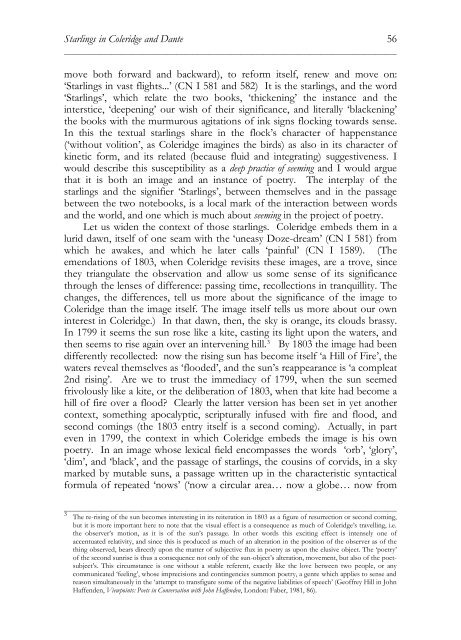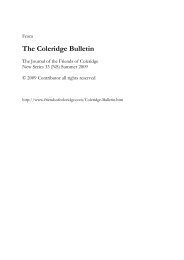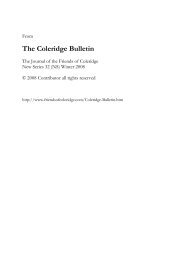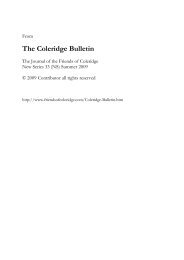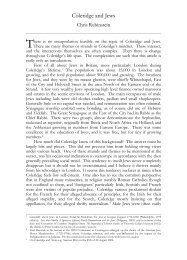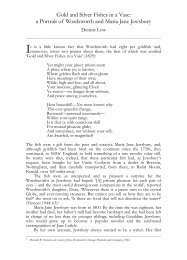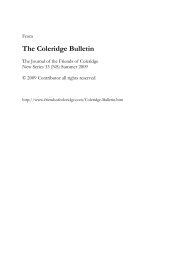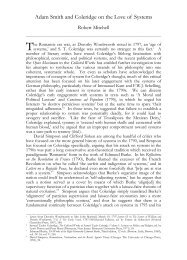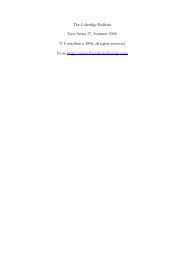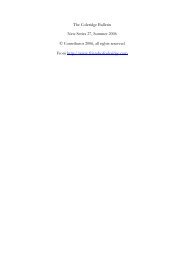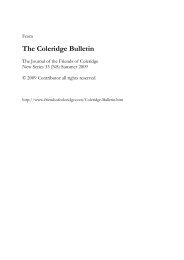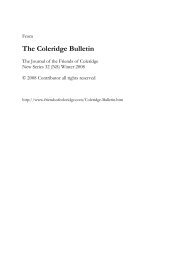'Thickening, deepening, blackening': Starlings and the Object of Poetry
'Thickening, deepening, blackening': Starlings and the Object of Poetry
'Thickening, deepening, blackening': Starlings and the Object of Poetry
Create successful ePaper yourself
Turn your PDF publications into a flip-book with our unique Google optimized e-Paper software.
<strong>Starlings</strong> in Coleridge <strong>and</strong> Dante 56<br />
____________________________________________________________________________________________<br />
move both forward <strong>and</strong> backward), to reform itself, renew <strong>and</strong> move on:<br />
‘<strong>Starlings</strong> in vast flights...’ (CN I 581 <strong>and</strong> 582) It is <strong>the</strong> starlings, <strong>and</strong> <strong>the</strong> word<br />
‘<strong>Starlings</strong>’, which relate <strong>the</strong> two books, ‘thickening’ <strong>the</strong> instance <strong>and</strong> <strong>the</strong><br />
interstice, ‘<strong>deepening</strong>’ our wish <strong>of</strong> <strong>the</strong>ir significance, <strong>and</strong> literally ‘blackening’<br />
<strong>the</strong> books with <strong>the</strong> murmurous agitations <strong>of</strong> ink signs flocking towards sense.<br />
In this <strong>the</strong> textual starlings share in <strong>the</strong> flock’s character <strong>of</strong> happenstance<br />
(‘without volition’, as Coleridge imagines <strong>the</strong> birds) as also in its character <strong>of</strong><br />
kinetic form, <strong>and</strong> its related (because fluid <strong>and</strong> integrating) suggestiveness. I<br />
would describe this susceptibility as a deep practice <strong>of</strong> seeming <strong>and</strong> I would argue<br />
that it is both an image <strong>and</strong> an instance <strong>of</strong> poetry. The interplay <strong>of</strong> <strong>the</strong><br />
starlings <strong>and</strong> <strong>the</strong> signifier ‘<strong>Starlings</strong>’, between <strong>the</strong>mselves <strong>and</strong> in <strong>the</strong> passage<br />
between <strong>the</strong> two notebooks, is a local mark <strong>of</strong> <strong>the</strong> interaction between words<br />
<strong>and</strong> <strong>the</strong> world, <strong>and</strong> one which is much about seeming in <strong>the</strong> project <strong>of</strong> poetry.<br />
Let us widen <strong>the</strong> context <strong>of</strong> those starlings. Coleridge embeds <strong>the</strong>m in a<br />
lurid dawn, itself <strong>of</strong> one seam with <strong>the</strong> ‘uneasy Doze-dream’ (CN I 581) from<br />
which he awakes, <strong>and</strong> which he later calls ‘painful’ (CN I 1589). (The<br />
emendations <strong>of</strong> 1803, when Coleridge revisits <strong>the</strong>se images, are a trove, since<br />
<strong>the</strong>y triangulate <strong>the</strong> observation <strong>and</strong> allow us some sense <strong>of</strong> its significance<br />
through <strong>the</strong> lenses <strong>of</strong> difference: passing time, recollections in tranquillity. The<br />
changes, <strong>the</strong> differences, tell us more about <strong>the</strong> significance <strong>of</strong> <strong>the</strong> image to<br />
Coleridge than <strong>the</strong> image itself. The image itself tells us more about our own<br />
interest in Coleridge.) In that dawn, <strong>the</strong>n, <strong>the</strong> sky is orange, its clouds brassy.<br />
In 1799 it seems <strong>the</strong> sun rose like a kite, casting its light upon <strong>the</strong> waters, <strong>and</strong><br />
<strong>the</strong>n seems to rise again over an intervening hill. 3<br />
By 1803 <strong>the</strong> image had been<br />
differently recollected: now <strong>the</strong> rising sun has become itself ‘a Hill <strong>of</strong> Fire’, <strong>the</strong><br />
waters reveal <strong>the</strong>mselves as ‘flooded’, <strong>and</strong> <strong>the</strong> sun’s reappearance is ‘a compleat<br />
2nd rising’. Are we to trust <strong>the</strong> immediacy <strong>of</strong> 1799, when <strong>the</strong> sun seemed<br />
frivolously like a kite, or <strong>the</strong> deliberation <strong>of</strong> 1803, when that kite had become a<br />
hill <strong>of</strong> fire over a flood? Clearly <strong>the</strong> latter version has been set in yet ano<strong>the</strong>r<br />
context, something apocalyptic, scripturally infused with fire <strong>and</strong> flood, <strong>and</strong><br />
second comings (<strong>the</strong> 1803 entry itself is a second coming). Actually, in part<br />
even in 1799, <strong>the</strong> context in which Coleridge embeds <strong>the</strong> image is his own<br />
poetry. In an image whose lexical field encompasses <strong>the</strong> words ‘orb’, ‘glory’,<br />
‘dim’, <strong>and</strong> ‘black’, <strong>and</strong> <strong>the</strong> passage <strong>of</strong> starlings, <strong>the</strong> cousins <strong>of</strong> corvids, in a sky<br />
marked by mutable suns, a passage written up in <strong>the</strong> characteristic syntactical<br />
formula <strong>of</strong> repeated ‘nows’ (‘now a circular area… now a globe… now from<br />
____________________________________________________________________________________________<br />
3 The re-rising <strong>of</strong> <strong>the</strong> sun becomes interesting in its reiteration in 1803 as a figure <strong>of</strong> resurrection or second coming,<br />
but it is more important here to note that <strong>the</strong> visual effect is a consequence as much <strong>of</strong> Coleridge’s travelling, i.e.<br />
<strong>the</strong> observer’s motion, as it is <strong>of</strong> <strong>the</strong> sun’s passage. In o<strong>the</strong>r words this exciting effect is intensely one <strong>of</strong><br />
accentuated relativity, <strong>and</strong> since this is produced as much <strong>of</strong> an alteration in <strong>the</strong> position <strong>of</strong> <strong>the</strong> observer as <strong>of</strong> <strong>the</strong><br />
thing observed, bears directly upon <strong>the</strong> matter <strong>of</strong> subjective flux in poetry as upon <strong>the</strong> elusive object. The ‘poetry’<br />
<strong>of</strong> <strong>the</strong> second sunrise is thus a consequence not only <strong>of</strong> <strong>the</strong> sun-object’s alteration, movement, but also <strong>of</strong> <strong>the</strong> poetsubject’s.<br />
This circumstance is one without a stable referent, exactly like <strong>the</strong> love between two people, or any<br />
communicated ‘feeling’, whose imprecisions <strong>and</strong> contingencies summon poetry, a genre which applies to sense <strong>and</strong><br />
reason simultaneously in <strong>the</strong> ‘attempt to transfigure some <strong>of</strong> <strong>the</strong> negative liabilities <strong>of</strong> speech’ (Ge<strong>of</strong>frey Hill in John<br />
Haffenden, Viewpoints: Poets in Conversation with John Haffenden, London: Faber, 1981, 86).


